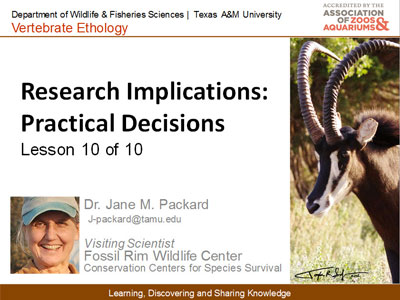 |
Organizational Communication: Relational Context and Organizations |
0.75 |
The relational context of a communication exchange includes the circumstances, within an organization, that necessitate this exchange between employees. A number of factors affect the relational context, including the status of the employees within the organization, their motivation, and their relationship with other employees. All communication within an organization depends on the intent of the participants.
In this course you will learn to: identify the relational context and the factors that influence it, and identify the different personality types, and develop individual-organizational relationships. |
 |
Organizational Communication: Relational Context and Organizations (Instructor Guide) |
0.75 |
The relational context of a communication exchange includes the circumstances, within an organization, that necessitate this exchange between employees. A number of factors affect the relational context, including the status of the employees within the organization, their motivation, and their relationship with other employees. All communication within an organization depends on the intent of the participants.
In this course you will learn to: identify the relational context and the factors that influence it, and identify the different personality types, and develop individual-organizational relationships.
This Instructor's Edition of this course includes notes and suggestions to assist you in presenting the material, whether in an in-person classroom setting, or as an instructor-led online or distance-learning course. It also provides you with the answers to questions found in mid-lesson activities, as well as in the quiz that concludes the course. |
 |
Research Implications for Practical Decisions |
1.00 |
The researchers on your team have presented you with the results of their behavioral inquiry. Now you are ready to decide what this means in terms of adaptive management to meet your goals for the animals under your care. Listen as practitioners and researchers return to the "3 C's" to discuss the practical implications of a behavioral study |
 |
Building Upward: Resuscitation of Anaphylactic Shock Part 2—Scenario 1 |
1.00 |
The second part of this series is the first of three scenarios. All three scenarios are designed to review complicated situations that BLS providers may be asked to navigate. This scenario has us consider the care of an anaphylactic patient in the setting of a pregnancy. Paramedic student Vanessa Petote does an excellent job of interviewing Dr. Jeremy Cushman. Final Exam: Please read each question carefully. You will have two attempts to gain a 70% or higher on this exam. If you are not successful in two attempts, you are welcome to take the course again to gain the certification. |
 |
Integrating Plants and Animals at San Diego Zoo Safari Park |
1.00 |
The task of how to maintain a healthy plant collection in and around animal exhibits in zoos, for the benefit of the animals and guests, is a challenge. This webinar will show the techniques used for selection, installation and maintenance of trees and other plants, for bird, small and large mammal, primate and multi species exhibits. It will give real examples of plants that work, and those that don’t, and techniques you can implement to ensure the best possible integration for both the plants and animals. Although focused on the Southern California climate zones, many of the principles are applicable at zoos nationwide. |
 |
Business Accounting: Accounting for Inventory |
1.00 |
The term inventory refers to the assets that a company holds for resale in the normal course of business. It is important to distinguish between the types of inventory costs incurred and how the inventory costs are calculated. |
 |
Bedrock: Therapeutic Communications for EMS |
1.00 |
The topic of therapeutic communications relates to nearly every EMS response and is especially important for high-acuity situations. Elizabeth C. Shannon, EMT, MS, RN, PMHNP-BC, brings her years of experience as a mental health care provider and an EMT to the table in this insightful discussion. As you hear her navigate the questions posed, we hope that you will confirm what you are already doing well. We also hope that your reflection on the subject will lead to improved EMS responses for you and the other medics on your crew.
Final Exam: Please read each question carefully. You will have two attempts to gain a 75% or higher on this exam. If you are not successful in two attempts, you are welcome to take the course again to gain the certification. |
 |
Saving the Tuatara: Habitat Restoration on Stephens Island, New Zealand |
1.00 |
The Tuatara, a prehistoric reptile from New Zealand, often considered to be a "Living Fossil," is making a comeback. Long extinct from the mainland and now only found on a few islands, the Tuatara is getting help. In this presentation we go to Stephens Island, New Zealand to take part in a 10 day re-vegetation project aimed at providing Tuataras with an ideal habitat for the future. Stephens Island is home to over half of the world's Tuatara population. It is an amazing island, fitting for an amazing creature. |
 |
Equal Opportunity 101 (Corrections) |
0.17 |
The U.S. Department of Labor Civil Rights Center is committed to providing clear and easy-to-access information on how to comply with federal equal opportunity and nondiscrimination laws and regulations that (1) prohibit discrimination in DOL-funded programs and activities, and (2) prohibit discrimination on the basis of disability by certain public entities and in DOL-conducted activities. This course is a brief overview on equal opportunity rights. |
 |
Video Analysis: Activities and Events |
1.00 |
The video-data for your inquiry project has been collected, now what? Testing your hypothesis is usually a dance, back and forth between the "ideal" and "reality-check". Listen to a research team decide how they will analyze video-data to extract just the information needed to focus on the inquiry questions. The first step is to sort video clips by activity categories, then score each clip using a recording protocol defined in terms of counting behavioral events and/or time sampling of activity states. |











